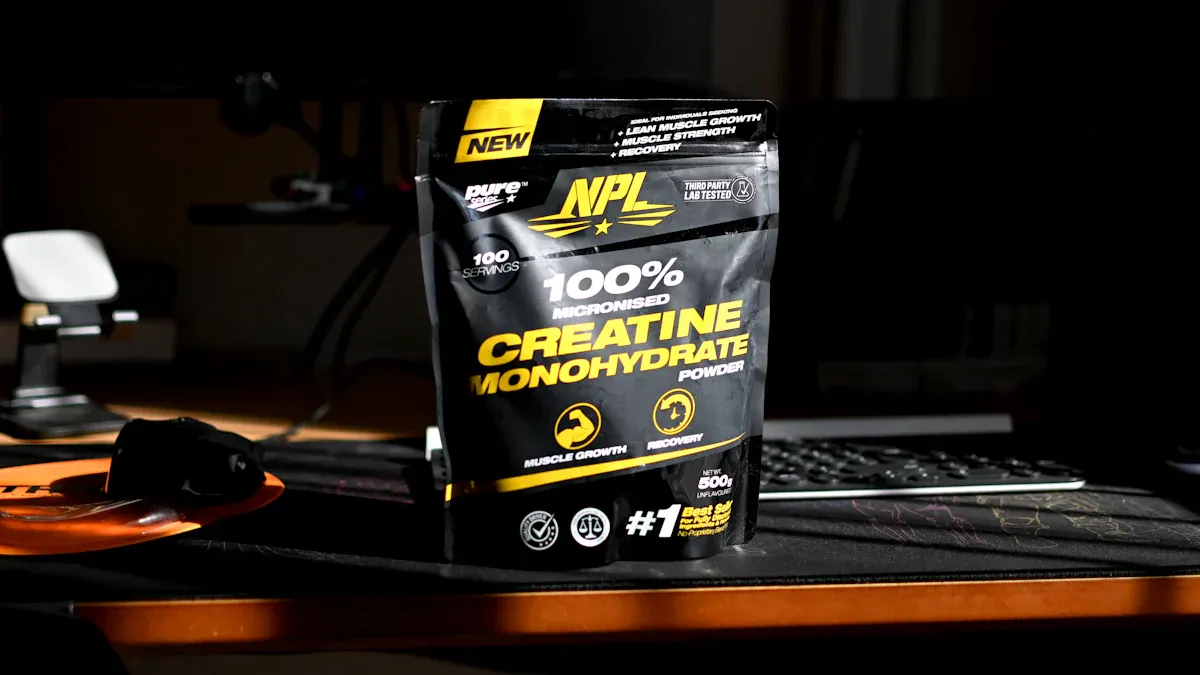
Creatine helps improve how well your body performs and recovers. Out of all its types, creatine monohydrate is the most studied. Research shows it works really well. For example, one review found creatine improved both endurance and strength. Another study showed just two days of use boosted power by 4%. Other types, like creatine HCL or buffered creatine, are available. But they don’t have as much research as creatine monohydrate. This is why most athletes and fitness fans choose creatine monohydrate.
Key Takeaways
Creatine monohydrate is the most studied and effective type of creatine.
It can help you perform better in short, hard activities like lifting weights or running fast.
Creatine lowers muscle soreness and damage, helping you recover quicker after exercise.
It is safe for most people, with very few side effects found in long-term research.
Creatine monohydrate is cheap and easy to buy, making it a good option for improving fitness.
Other types of creatine, like HCL or buffered creatine, might not work better than monohydrate, even if some say they do.
Mixing creatine monohydrate with water or a shake is easy and works well for daily use.
To get the best results, take creatine regularly and start with monohydrate if you’re new to using supplements.
What Is Creatine?
Role of Creatine in the Body
Creatine is a natural substance found mostly in muscles. It helps your body make energy, especially during hard activities. Your body makes creatine from amino acids and stores it as phosphocreatine in muscles. This stored energy helps make ATP, which is the main energy source for your cells.
When you do tough exercises like running or lifting weights, your muscles need quick energy. Creatine helps by refilling ATP levels so you can keep going longer. Studies show creatine can improve how your cells make energy. It also helps stop muscle loss by keeping muscles healthy.
How It Works | What It Does |
|---|---|
Creatine Kinase | Moves energy from phosphocreatine to ATP to give power. |
Creatine Kinase Isoforms | Different types help energy needs in various body parts. |
Creatine does more than just give energy. It helps cells stay healthy by improving how mitochondria work. This makes it important for better muscle performance and energy levels.
Benefits for Performance and Recovery
Creatine has many benefits for exercise and recovery. It is known for boosting performance in short, powerful activities. For example, creatine monohydrate can make you stronger and help muscles grow when paired with weight training. This is why athletes and gym-goers like it.
One big benefit is that creatine reduces muscle tiredness. By refilling ATP, it helps you work harder and recover faster. Research shows it also lowers muscle damage and swelling after workouts. A study found creatine reduced soreness and stress in muscles after exercise.
Main benefits of creatine include:
More strength and power.
Faster recovery after workouts.
Less muscle damage and swelling.
Result Type | Creatine Group Outcome | Effect Size (SMD) | p-value |
|---|---|---|---|
Muscle damage markers (48-90h later) | Lower | -1.09 | 0.03 |
Soreness (24h later) | Lower | -0.66 | N/A |
Stress markers (24-36h later) | Lower | -1.37 | N/A |
Creatine is not just for athletes. It helps anyone wanting better muscle performance and recovery. Whether you want to get stronger, perform better, or recover quicker, creatine can help.
Overview of Creatine Monohydrate
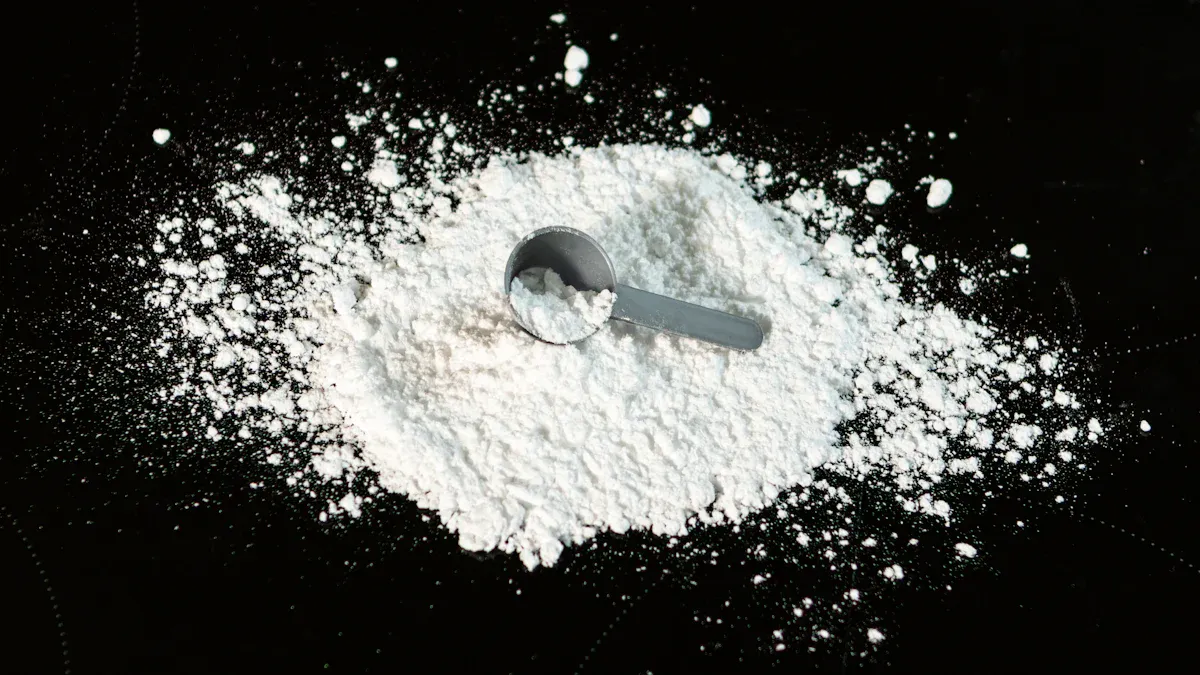
Effectiveness and Research
Creatine monohydrate is the best type of creatine. Studies show it helps with short, powerful activities. It can make you lift heavier weights and run faster. It also helps you recover quickly after exercise. This is why athletes and gym-goers like it.
Creatine monohydrate doesn’t just help your body; it helps your brain too. Research shows it improves memory, focus, and thinking speed. These benefits make it useful for both physical and mental health.
It works by increasing energy stores in your muscles. This gives you more power during tough activities. Whether you want to get stronger or recover faster, creatine monohydrate is proven to work.
Safety Profile
Creatine monohydrate is very safe to use. Long-term studies show it doesn’t cause major side effects. For example, research found only a tiny number of bad reactions to creatine. Out of millions of reports, only a few were linked to creatine.
Even if you use it for a long time, it won’t harm your health. A study on football players showed no kidney problems after 21 months of use. This makes creatine monohydrate a safe choice for everyone.
Some people worry about bloating, but this is rare and temporary. Most people use creatine monohydrate without any problems. It’s one of the safest supplements you can take.
Cost and Accessibility
Creatine monohydrate is effective and affordable. Powdered creatine is the cheapest option and easy to mix. You can add it to water or your favorite drink. It gives you more servings for less money compared to capsules.
The creatine market is growing fast because more people know its benefits. In 2023, it was worth $550 million and could reach $972 million by 2032. This shows how popular it is among fitness fans.
You can buy creatine monohydrate in stores or online. Websites let you compare prices and read reviews to find the best product. Its low cost and easy availability make it a great choice for improving performance and recovery.
Why It’s the Gold Standard
Creatine monohydrate is the best among creatine supplements. It has been studied for many years and shows great results. Over 500 studies prove it works well. Athletes, fitness fans, and scientists trust it for building strength, power, and muscles.
The International Society of Sports Nutrition calls creatine monohydrate the best supplement for athletes. It helps with tough workouts and builds lean muscle. This expert approval makes it the top choice for improving physical performance.
People who use it are very happy with the results. Surveys show 91% of users see benefits from creatine monohydrate. This high satisfaction proves it works well for fitness goals. Whether you want to lift more, run faster, or recover quickly, this supplement helps.
Tip: If you’re new to creatine, start with creatine monohydrate. It’s safe, works well, and is easy to find.
Another reason creatine monohydrate is the best is its simple formula. It only has creatine and water, so it’s pure and has no extra stuff. Your body absorbs it easily, and it works without needing fancy ingredients.
It’s also very affordable. You get more servings for less money compared to other types. Powdered creatine monohydrate is popular because it mixes easily with water or shakes. It’s cheap and convenient for everyone.
Creatine monohydrate is trusted because science and users back it up. Whether you’re an athlete, gym-goer, or just want to get fitter, this supplement is reliable and gives great results.
Overview of Other Forms of Creatine
Creatine HCL
Creatine HCL is a newer type of creatine. It dissolves better in water than creatine monohydrate. This makes it a good choice for people who dislike gritty textures. You only need 1-2 grams daily because it absorbs faster.
Some say Creatine HCL absorbs better than monohydrate. But there isn’t enough research to prove this long-term.
Studies show no big performance difference between Creatine HCL and monohydrate. For example:
A study compared 3 grams of Creatine HCL to 20 grams of monohydrate. Both worked equally well.
Creatine HCL may cause less bloating, which helps people with sensitive stomachs.
Property | Creatine Monohydrate | Creatine HCL |
|---|---|---|
Effective Dosage | 3-5 grams per day | 1-2 grams per day |
Solubility in Water | Low | High |
Absorption Rate | Moderate | Potentially Faster |
Common Side Effects | Mild Bloating | Minimal Bloating |
If you want smaller doses and better mixing, try Creatine HCL. But it costs more and isn’t proven to be better than monohydrate.
Creatine Ethyl Ester
Creatine Ethyl Ester (CEE) is another creatine option. It was made to absorb better and reduce water weight. But studies show it doesn’t work as well as promised.
Research shows CEE quickly turns into creatinine, a waste product. This makes it less effective than other creatine types.
In tests, CEE didn’t improve strength or exercise results better than monohydrate or even a placebo. It didn’t help with muscle growth or performance. This means CEE may not be worth the higher price.
If you’re thinking about CEE, compare its cost and weak results to creatine monohydrate’s proven benefits.
Creatine Nitrate
Creatine Nitrate (CrN) mixes creatine with nitrate. Nitrates help blood flow and bring oxygen to muscles. This might improve exercise performance.
Studies show creatine nitrate works as well as monohydrate. In one test, people taking 3 grams of creatine nitrate had similar results to those taking 3 grams of monohydrate. Both groups got stronger and had more power.
Creatine nitrate works, but it costs more and is harder to find. If you want better blood flow along with creatine’s benefits, creatine nitrate could be a good choice.
Buffered Creatine (Kre-Alkalyn)
Buffered creatine, also called Kre-Alkalyn, is a changed form of creatine. It’s made to be more stable and absorb better. Makers say its higher pH stops it from turning into creatinine, a waste product. This means you can take less and still get the same effects as creatine monohydrate.
But studies don’t fully agree with these claims. Research shows Kre-Alkalyn and creatine monohydrate give similar results. They both help with strength, power, and recovery. There’s no big difference in muscle creatine levels, body changes, or workout improvements. The table below shows these findings:
Aspect | Kre-Alkalyn (Buffered Creatine) | Creatine Monohydrate |
|---|---|---|
Muscle Creatine Content | No big change | No big change |
Body Composition | No big change | No big change |
Training Adaptations | No big change | No big change |
Side Effects | No fewer side effects | N/A |
One possible benefit of Kre-Alkalyn is less bloating or stomach upset. If your stomach is sensitive, this might be easier for you. But Kre-Alkalyn costs more than creatine monohydrate. It doesn’t offer better performance for the extra price.
If you’re thinking about Kre-Alkalyn, compare its cost to its benefits. For most people, creatine monohydrate is cheaper and works just as well.
Liquid Creatine
Liquid creatine is another option that’s easy to use. It comes pre-mixed, so you don’t need to stir powders. This makes it handy if you’re busy or don’t want to carry extra gear to the gym.
However, research shows liquid creatine isn’t as good as it seems. Studies find that pre-mixed creatine breaks down into creatinine over time. This makes it less effective. The table below compares liquid creatine and creatine monohydrate for absorption and benefits:
Compound | Tissue Absorption | Plasma Creatine Levels | Muscle Creatine Levels | Brain Creatine Levels |
|---|---|---|---|---|
Creatyl-l-leucine (CLL) | No | No big increase | No big increase | No big increase |
Creatine Monohydrate (CrM) | Yes | Big increase | Big increase | Some increase |
These results show liquid creatine doesn’t work as well as creatine monohydrate. While it’s convenient, it’s less stable and less effective. For the best results, stick with powdered forms of creatine.
Tip: Want convenience? Mix creatine monohydrate in a shaker bottle before your workout. It’s portable and still works great.
Liquid creatine might be okay if you care more about ease than results. But for most people, powdered creatine is better for building strength, endurance, and recovery.
Head-to-Head Comparisons
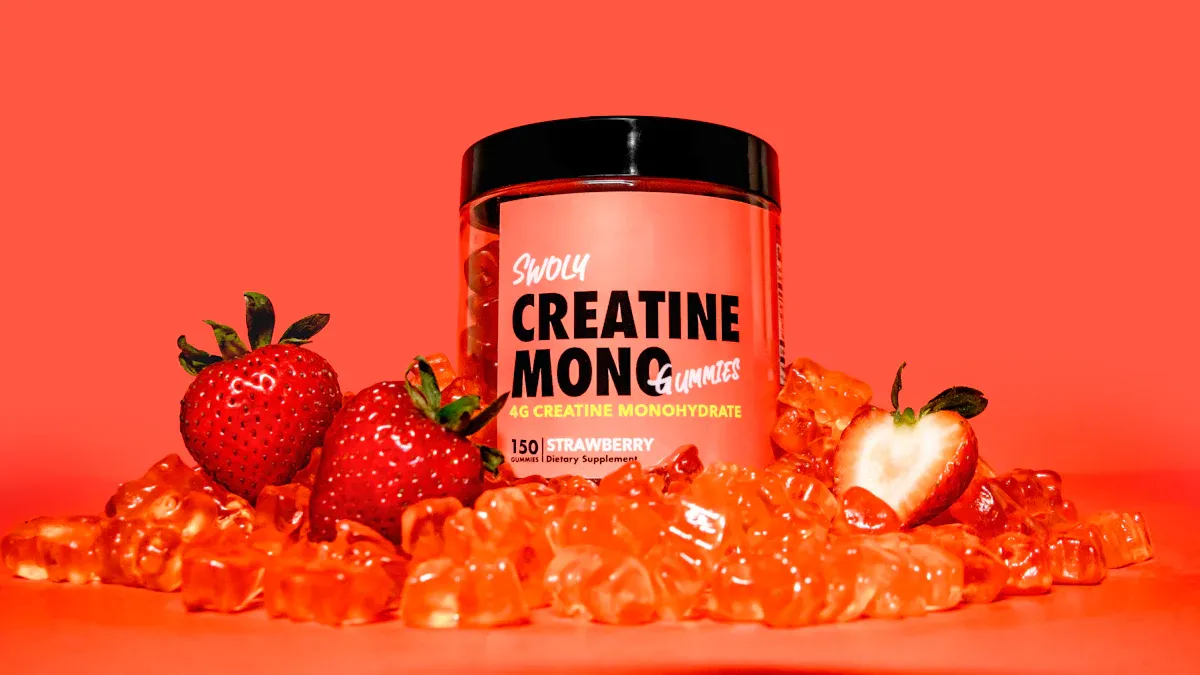
Monohydrate vs. HCL
When comparing creatine monohydrate and creatine HCL, there are key differences. Creatine HCL dissolves better in water. This makes it a good choice if you dislike gritty drinks. It also needs a smaller dose—just 1-2 grams daily. In contrast, monohydrate requires 3-5 grams per day. This smaller dose can be more convenient for some people.
For performance, both types work equally well. A study with weightlifters showed no big difference in strength or body changes. Both groups improved their one-rep max (1 RM) on the leg press. The HCL group lost a little more fat, but it wasn’t enough to make it better overall.
If your stomach is sensitive, HCL might cause less bloating. But for most people, monohydrate is the better option. It’s cheaper and has more research to support its benefits. You can find affordable creatine monohydrate here.
Monohydrate vs. Ethyl Ester
Creatine ethyl ester (CEE) was made to absorb better and reduce water weight. But studies show it doesn’t work as well as promised. Research comparing monohydrate and CEE found that monohydrate is better in many ways:
Monohydrate raised creatine levels in the blood more than CEE.
Muscle creatine content increased more with monohydrate than with CEE.
Neither type showed big changes in body composition, but monohydrate worked better overall.
These results show why monohydrate is still the best choice. It increases muscle creatine levels more effectively, which helps with strength and recovery. CEE breaks down faster into waste, making it less useful. If you want a reliable option, stick with monohydrate.
Monohydrate vs. Nitrate
Creatine nitrate mixes creatine with nitrate, which helps blood flow. This could improve oxygen delivery to muscles during workouts. While this sounds helpful, studies show creatine nitrate works about the same as monohydrate for strength and power.
One study compared 3 grams of nitrate to 3 grams of monohydrate. Both groups gained similar strength and performance. There were no major differences between them. The nitrate might help endurance athletes by improving circulation. But for most gym-goers, monohydrate gives the same results at a lower price.
Creatine nitrate is harder to find and costs more. If you’re thinking about trying it, decide if better blood flow is worth the extra money. For most people, monohydrate is the smarter and cheaper choice.
Tip: New to creatine? Start with monohydrate. It’s affordable, effective, and backed by years of research. Check out a trusted option here.
Kre-Alkalyn vs. Creatine Monohydrate
Kre-Alkalyn and creatine monohydrate both aim to boost strength and recovery. Kre-Alkalyn is a buffered type of creatine with a higher pH. This is said to make it more stable and reduce waste. Makers claim you can take less Kre-Alkalyn and still get the same results as creatine monohydrate.
But studies don’t fully agree with these claims. Research shows both Kre-Alkalyn and creatine monohydrate give similar results. They both improve muscle creatine levels, body changes, and workout performance. For example, one study found no big differences in weight or muscle creatine after seven days of use.
Study Title | Findings | Sample Size | Key Measurements |
|---|---|---|---|
Kre-Alkalyn® supplementation does not promote greater changes in muscle creatine content, body composition, or training adaptations in comparison to creatine monohydrate | No big differences in muscle creatine or body changes | 30 | Weight change from baseline to day seven was significant (62.19+5.57 vs 63.28+5.49 kg) |
Creatine monohydrate has been proven to work well for years. Another study showed it helped people gain muscle and strength. This makes it the more trusted choice for most users.
Study Title | Findings | Sample Size | Key Measurements |
|---|---|---|---|
Effects of Creatine Monohydrate and Polyethylene Glycosylated Creatine Supplementation on Muscular Strength, Endurance, and Power Output | Big increases in body mass and strength for creatine monohydrate group | 58 | Body mass and power output increased significantly for the CM group (p # 0.05) |
Kre-Alkalyn might help if creatine monohydrate causes bloating or stomach issues. Its higher pH could be easier on your stomach. But it costs more. For most people, creatine monohydrate is better because it’s cheaper, well-researched, and reliable.
Monohydrate vs. Liquid Creatine
Liquid creatine is easy to use. It comes pre-mixed, so you don’t need to measure or mix it. This is great if you’re busy. But liquid creatine isn’t as effective. Studies show it breaks down into waste over time, making it less useful.
Creatine monohydrate, when mixed fresh, stays stable and works better. It raises muscle creatine levels, helping with strength, endurance, and recovery. Liquid creatine doesn’t give the same benefits.
If you care more about convenience than results, liquid creatine might work for you. But if you want the best performance, creatine monohydrate is the better choice. You can mix it with water or a shake before your workout to get all the benefits.
Tip: Save time by mixing creatine monohydrate in a shaker bottle before your workout. It’s just as easy as liquid creatine but works much better.
Which Creatine Is Best for You?
Budget-Conscious Users
If you want a low-cost option, creatine monohydrate is the best choice. It helps with muscle growth, strength, and performance without costing too much. Over 1,000 studies prove it works as well or better than newer types. It also fully saturates muscles, so claims about better absorption from other forms aren’t true.
Here’s why creatine monohydrate is great for saving money:
Affordable Pricing: It’s much cheaper than types like creatine HCL or buffered creatine.
Easy to Find: You can buy it in stores or online, often in bulk to save more.
Proven Results: Decades of research show it boosts muscle mass, strength, and recovery.
If you want results without spending a lot, choose creatine monohydrate. Find an affordable option here.
Users with Sensitive Stomachs
If you have a sensitive stomach, picking the right creatine is important. While creatine monohydrate works for most people, some may feel bloated or have mild stomach upset. If this happens, try creatine HCL or buffered creatine (Kre-Alkalyn). These types are made to be gentler on your stomach.
Studies show how different doses affect stomach issues:
Treatment Group | Diarrhea Rate | Stomach Upset Rate | Belching Rate |
|---|---|---|---|
C5 (2 x 5-g doses) | 28.6% | 23.8% | 16.9% |
C10 (1 x 10-g dose) | 55.6% | N/A | N/A |
Placebo | 35.0% | N/A | N/A |
Buffered creatine, like Kre-Alkalyn, has a higher pH, which may reduce irritation. Creatine HCL dissolves better in water, so it’s less likely to cause bloating. However, these types cost more and don’t work better than creatine monohydrate. If you’re sensitive, start with smaller doses or try these alternatives.
Athletes Seeking Faster Absorption
If you’re an athlete, faster absorption might sound helpful. Creatine pyruvate and creatine HCL are said to absorb quicker than creatine monohydrate. Studies show creatine pyruvate reaches higher levels in the blood, but this doesn’t mean better muscle absorption or performance.
Peak Plasma Level | Notes | |
|---|---|---|
Creatine Pyruvate | Higher than CrM | Absorbs faster, but doesn’t improve muscle uptake or performance. |
Creatine Monohydrate | Baseline | Nearly 100% bioavailability, proven to work well. |
Creatine Citrate | Baseline | Similar absorption to CrM and CrPyr. |
Even though creatine pyruvate absorbs faster in the blood, it doesn’t improve muscle benefits. Creatine monohydrate still gives the same results at a lower price. For athletes doing intense workouts, creatine monohydrate is the best for strength and recovery.
Tip: Mix creatine monohydrate in a shaker bottle before your workout for easy use and great results. Check out a trusted option here.
Individuals Focused on Convenience
Choosing the right creatine type can make life easier. If you’re busy or want a simple routine, some forms are better.
Powdered creatine is the easiest for most people. You can mix it with water, juice, or shakes. It’s quick to prepare and works anywhere—at home or the gym. This makes it the most popular choice.
Why powdered creatine is easy to use:
It mixes fast in drinks, so it’s simple to take.
You can change the amount to fit your goals.
It’s light and easy to carry in small containers.
It costs less and gives more servings than capsules or liquids.
Liquid creatine might seem easy since it’s pre-mixed. But it breaks down over time, making it less effective. While it saves mixing time, it doesn’t work as well as powdered creatine. If results matter, powdered creatine is better.
Capsules are another option. They don’t need mixing, so they’re great for travel or busy days. Just take them with water and go. But capsules cost more and often require several pills for one dose. For most people, powdered creatine is cheaper and more practical.
Tip: Mix powdered creatine in a shaker bottle ahead of time. It’s portable and keeps things simple while still being effective.
Powdered creatine is the top choice because it’s affordable and easy to use. Whether you’re new to fitness or experienced, it fits into any routine and offers great value.
Creatine monohydrate works best for most people. It’s effective, safe, and affordable, making it a top pick for better performance and recovery. Other creatine types might help with fewer side effects or faster absorption. But they don’t have as much research as creatine monohydrate. Pick the creatine that matches your fitness goals. Whether you want stronger muscles, more power, or quicker recovery, the right creatine can help you succeed.
FAQ
When should you take creatine?
You can take creatine any time of the day. Many people like taking it after workouts to help muscles recover. The most important thing is using it daily to keep creatine levels steady.
Is loading creatine required?
You don’t have to load creatine. Loading means taking 20 grams a day for 5–7 days. Instead, you can take 3–5 grams daily. Both ways will fill your muscles with creatine over time.
Does creatine make you dehydrated?
No, creatine doesn’t cause dehydration. It actually helps muscles hold water, keeping them hydrated. Just drink enough water every day while using creatine.
Is creatine safe for teens?
Creatine is usually safe for teens who play sports or exercise. Still, it’s best to ask a doctor before starting. Teens should use the right dose and drink plenty of water.
Can creatine be mixed with other supplements?
Yes, you can mix creatine with protein shakes, pre-workouts, or BCAAs. Mixing doesn’t make creatine less effective. Use water or juice to mix it easily.
Does creatine make you gain weight?
Creatine might make you gain a little weight from water in your muscles. This isn’t fat but extra hydration. Over time, it can also help build muscle, adding healthy weight.
How soon will creatine work?
If you load creatine, you might see results in 1–2 weeks. Without loading, it could take 3–4 weeks. You’ll likely notice more strength, energy, and faster recovery first.
Do vegetarians benefit more from creatine?
Yes, vegetarians often have lower creatine levels because of their diet. Taking creatine can raise their muscle creatine levels, helping with energy and recovery.
Tip: Stick to the recommended dose and use creatine daily for the best results.
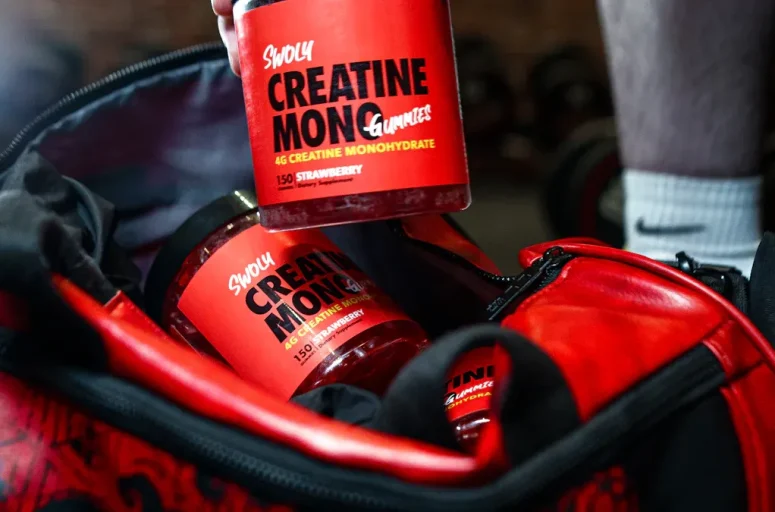

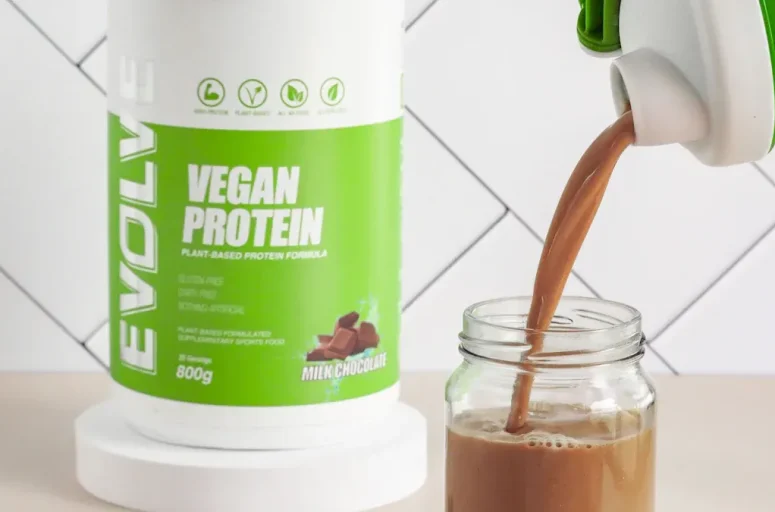
3 comments